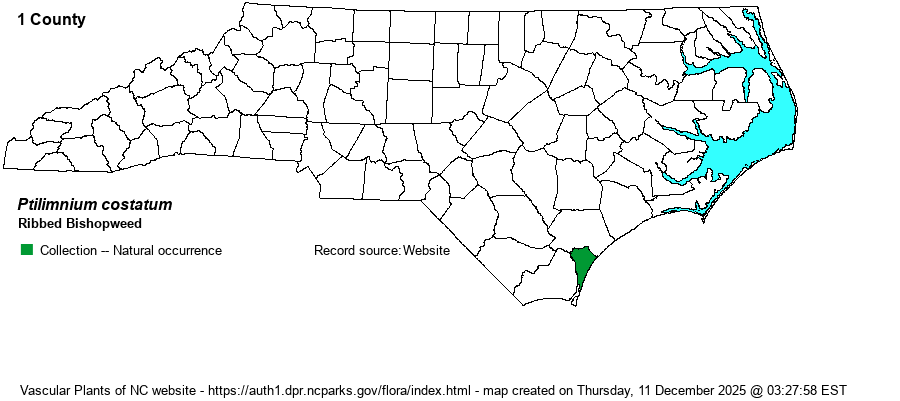| Author | (Elliott) Rafinesque | |
| Distribution | Known to occur only in the marshes just west of Wilmington, so far collected in New Hanover County, but presumably occurs in neighboring Brunswick County.
This species occurs mainly in the Mississippi drainage, from southern IL south to northeastern AR , but it ranges east sparingly to southeastern NC, a few places in GA, central TN, and AL. There appear to be no records yet for SC or FL.
| |
| Abundance | There is one moderate population in the Cape Fear/Brunswick River marshes area, often 100 or more plants noted. But, of course it is extremely rare in NC as a whole. This is a State Threatened species. NatureServe had a Global Rank of G4 for this species including TX and LA in the range, but some botanists consider that the TX-LA population is another species; thus, in 2024, Nature Serve moved the Rank to GNR (Not Ranked), owing to this uncertainty of what constitutes P. costatum now. | |
| Habitat | In NC it is found only in extensive tidal freshwater marshes. | |
| Phenology | Blooms from June to October, and fruits from mid-July to October. However, one record says "in early bud" on 7 August, and thus perhaps it does not normally bloom until well into August, which would be later than the other two similar species -- P. ahlesii and P. capillaceum, which should be finished blooming by early to mid-August, though the last can bloom until later in August. | |
| Identification | This is a robust and rather tall species, usually about 3-4 feet tall, in keeping with much or most of the surrounding and competing vegetation in the Cape Fear marshes. It is normally branched above. The scattered stem leaves are oblong in outline but are finely dissected as in the other two species. However, in this species the leaf segments are in whorls along the leaf axis (rachis), and quite crowded, rather than coming off the rachis mostly alternate. This gives a leaf a different look, and also there is a distinct petiole (the other two have essentially sessile leaves). The umbels of small white flowers are fairly typical for the group. Thus, to identify this rare species, look for a plant that grows waist high or taller, to rule out the other two, and leaves with an oblong (as opposed to a wider and more fan-shaped) outline, with a distinct linear leaf axis that has numerous whorls of filamentous leaflets. | |
| Taxonomic Comments | None
| |
| Other Common Name(s) | Big Bishopweed, Big Mock-bishopweed, Ribbed Mock-bishopweed | |
| State Rank | S1 | |
| Global Rank | GNR [G4] | |
| State Status | T | |
| US Status | | |
| USACE-agcp | FACW link |
| USACE-emp | FACW link |

